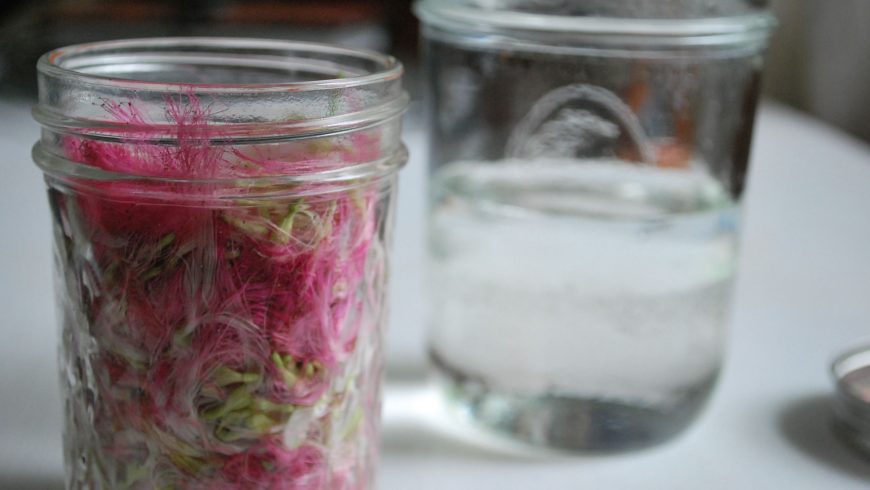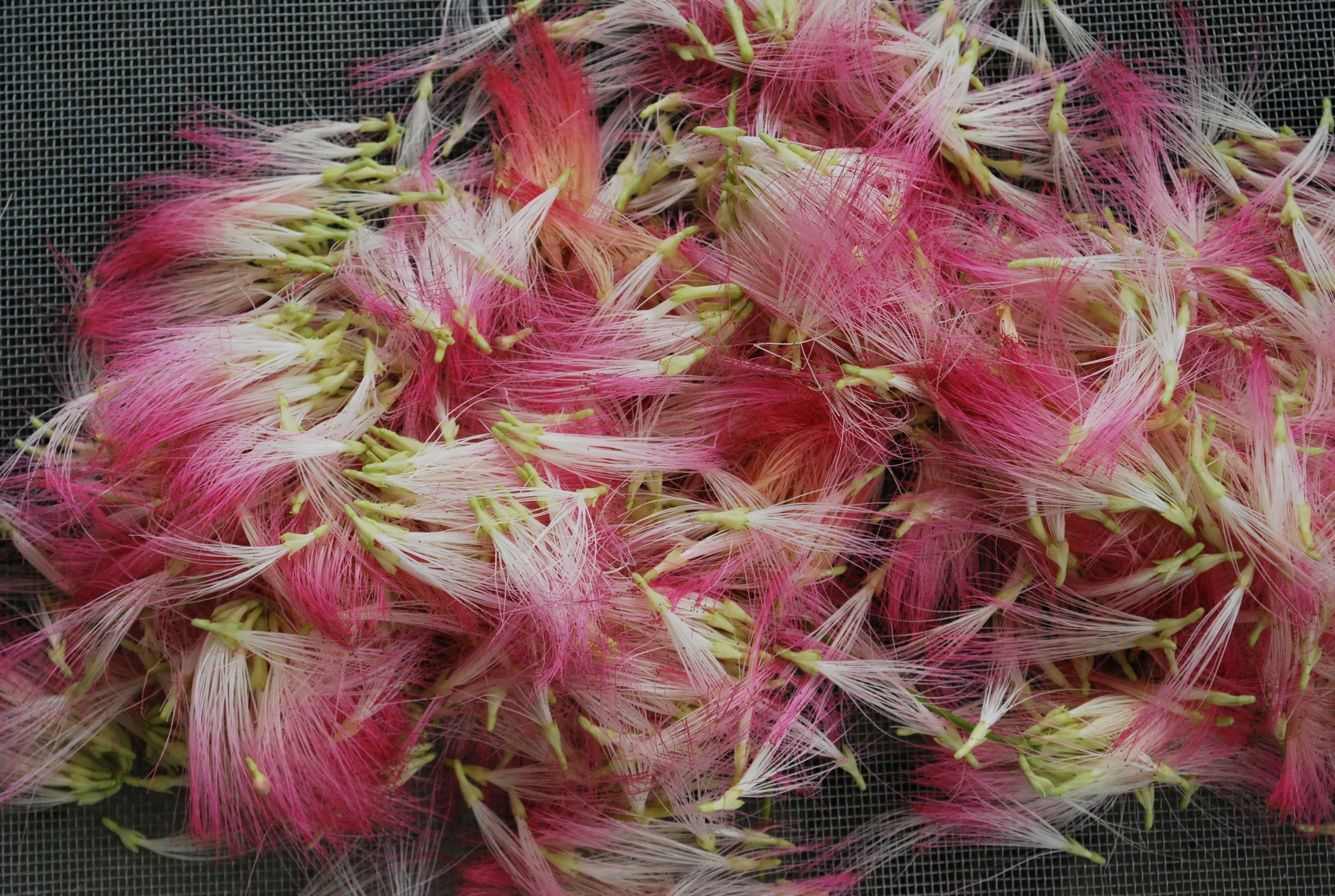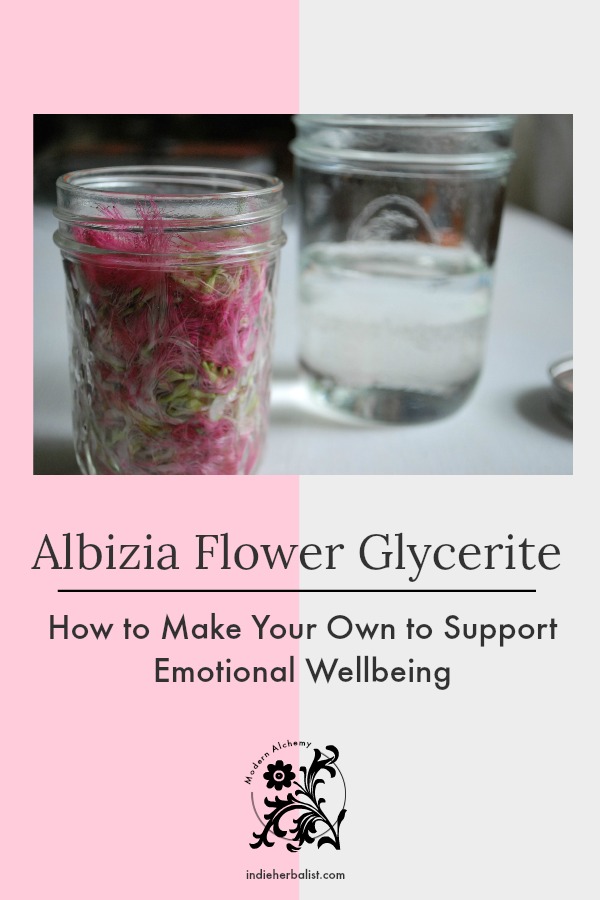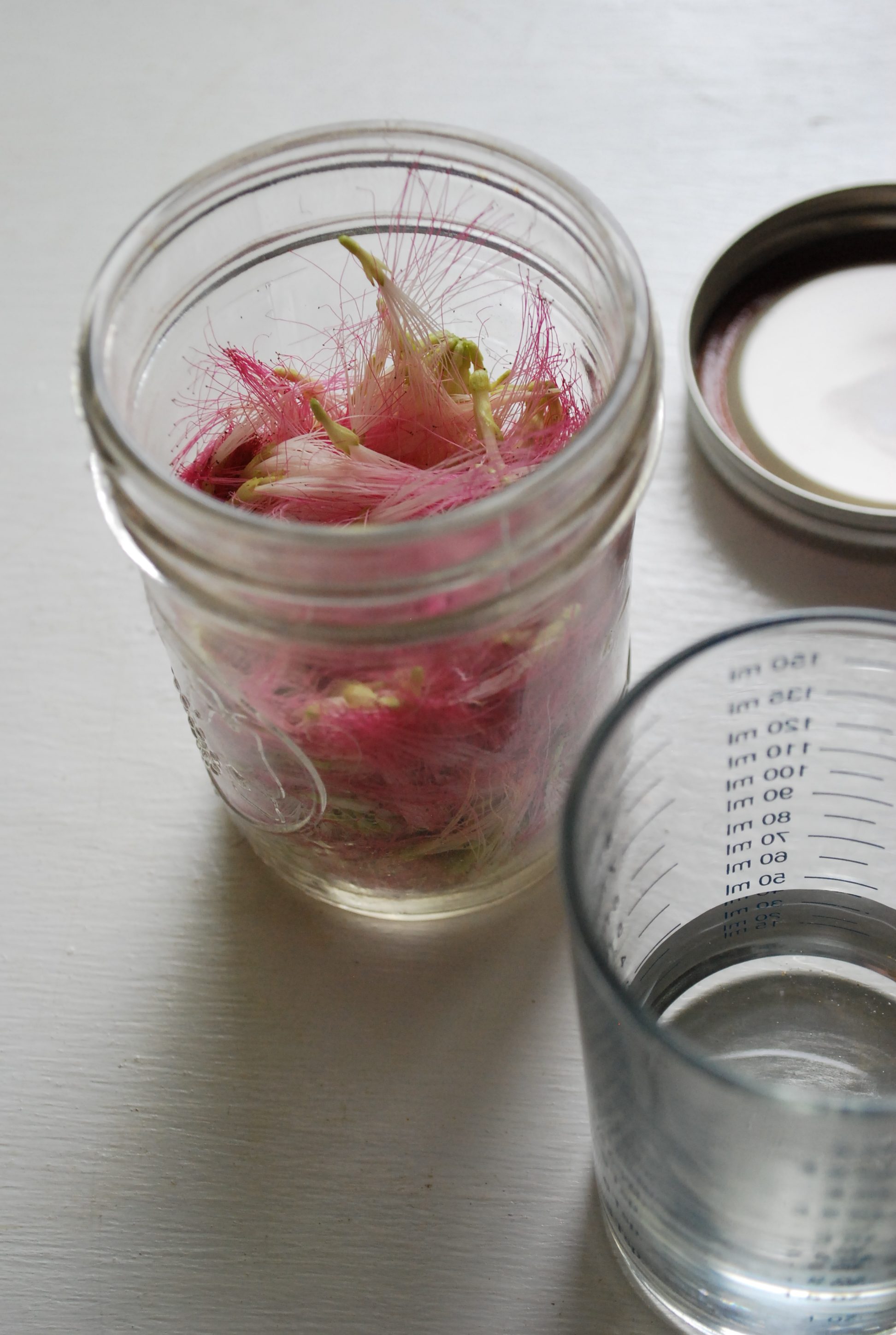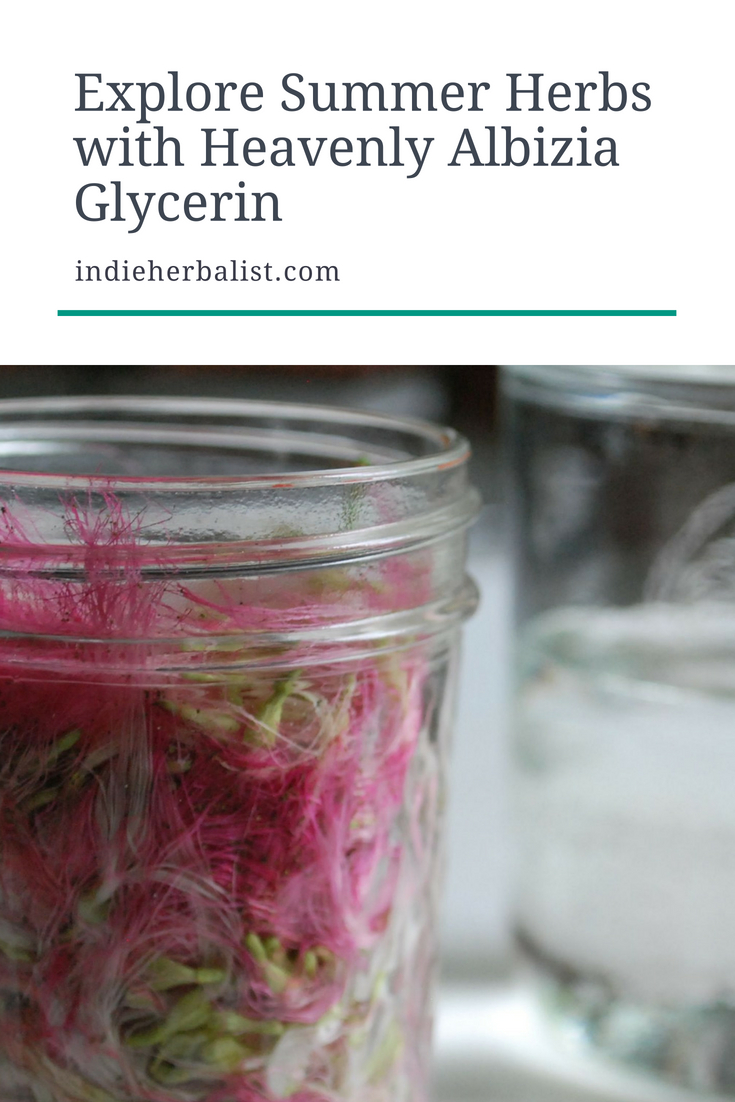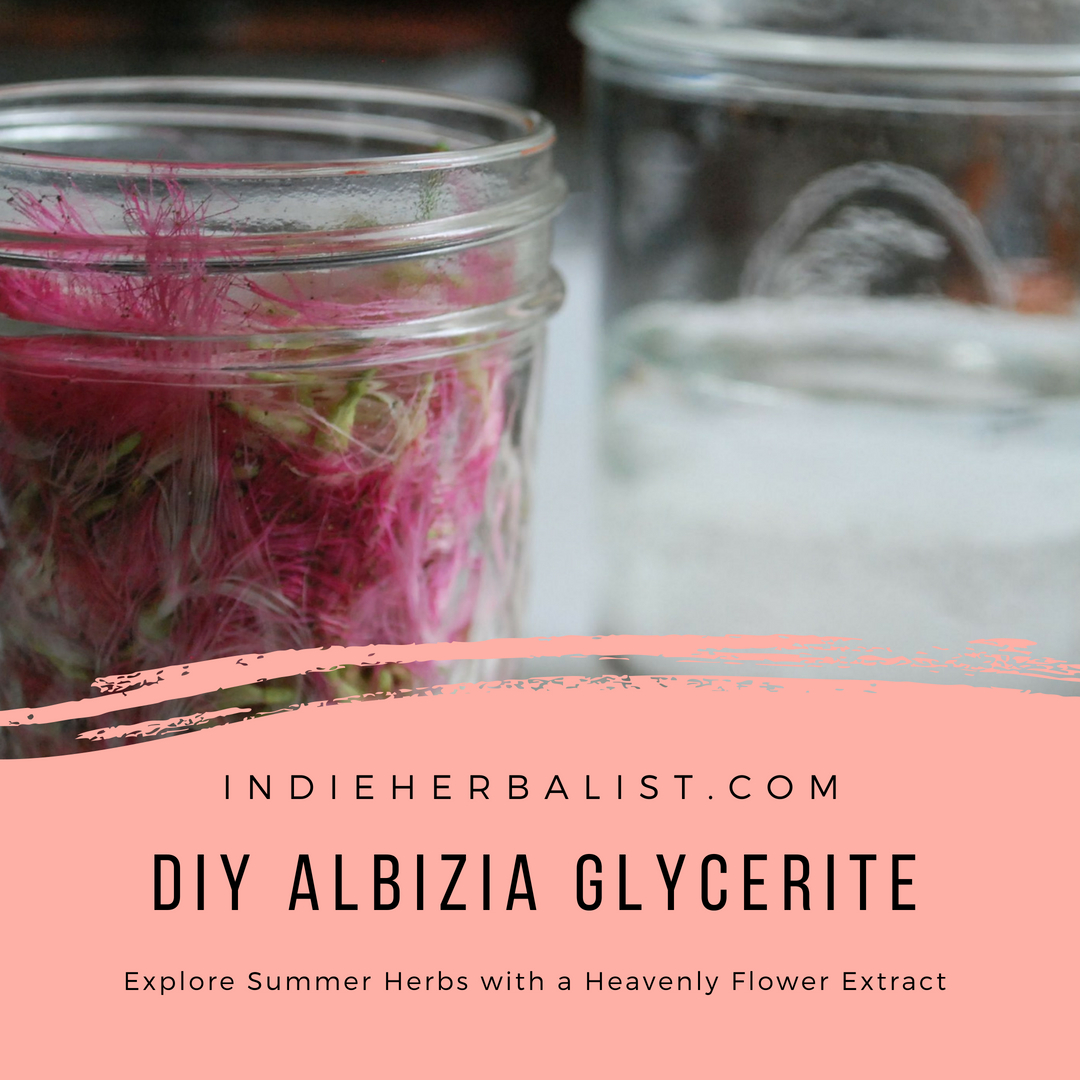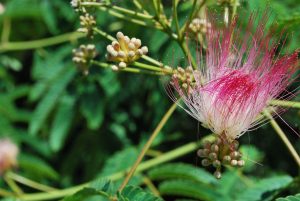Links contained in this post and elsewhere on my website may include affiliate links. When you make a purchase through these links, I earn a commission at no additional cost to you. I only link to products and services that I love - and that I think you will love, too!
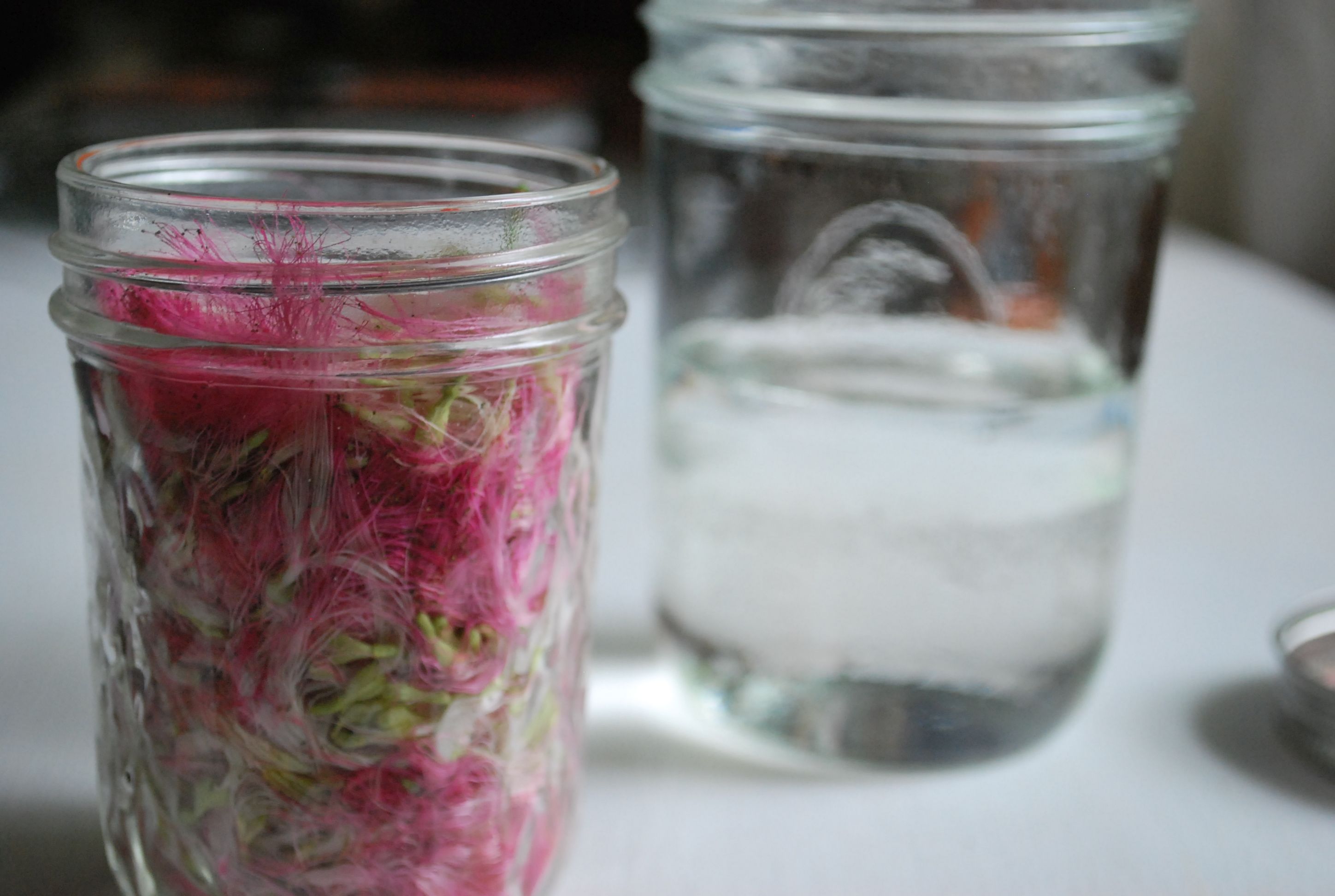
Welcome to Modern Alchemy Mondays! We will be exploring herbs and herbal preparations in this mainstay weekly feature. Today, I’m going to walk you through one of my favorite summer projects: making a heavenly herbal glycerin (aka glycerite) from albizia flowers.
Albizia, or mimosa, flowers are small tufts of pink adorning the Albizia julibrissin trees from May through June in our area. If you are fortunate to wander underneath the boughs, you will discover the heady, divine fragrance that perfumes the hot summers here. The scent reminds me of peaches and gardenias- a characteristically southern fragrance from a tree that, surprisingly, isn’t originally native to the US.
Another name for this herb is “Tree of Happiness.” Hummingbirds and bees love albizia and add their drowsy, mesmerizing hum and chittering to the ambiance. A quiet afternoon under an albizia tree can be a magical experience, and all the more so when you realize that these blossoms have yet another gift to offer besides their beauty and fragrance. They are beloved by herbalists as a nervine- an herb that supports emotional wellness and the health of the nervous system.
A Note on Safety
Albizia is a wonderful ally for supporting someone working with heavy emotions. It’s uplifting and mildly euphoric, and the flowers are especially potent for this. It’s a beautiful summer herb that encourages you to relax and enjoy the day.
There is no modern safety information that I’m aware of on use of albizia during pregnancy. However, albizia is considered an herb which “moves the blood” according to traditional herbalism, and because of this is not recommended for use during pregnancy or while breastfeeding.
There’s also a possibility that albizia, like other nervine herbs , might potentiate sedatives or interfere with psychiatric medications. If you are on prescription medications please talk to your doctor and your herbalist before deciding if albizia is an herb that might resonate well with you.
Making Herbal Glycerites
Have you ever used glycerin to make an alcohol free herbal extract? I know a lot of herbalists who rave about using glycerin, but I actually don’t like it very much for most applications. You can read the post where I dish on the differences between alcohol extracts and glycerin extracts for more info, but (spoiler) I typically prefer alcohol based extracts.
That being said, there is one application where I find that glycerin extracts ARE better than alcohol. When I want to preserve fresh herbs with high levels of volatile oils (present as wonderful fragrances in herbs like peppermint, lemon balm, monarda, and albizia), glycerin is my go-to.
Because they are so wonderfully aromatic, making a fresh flower glycerite is absolutely my favorite way to preserve albizia blossoms for later use. Using fresh albizia flowers in a simmered glycerite as below yields a preparation that is incredibly fragrant and (bonus) alcohol free.
How to Make Albizia Fresh Flower Glycerite
If you already know how to make jam or jellies, or do any home canning, you will have all of the tools you need to make your own fresh herb glycerites. Otherwise, you may need to collect a few things before you get started.
The yield for this will be slightly flexible based on how tightly you are able to pack the albizia flowers into the jar. I’ve based it off using a pint canning jar, which should yield around 8-12 oz of glycerite.
Here’s a list of what you will need.
- water bath canning pot and rack
- jar tongs
- 2 pint canning jars
- new lid and ring to process the jar of glycerite
- amber glass bottles
Step One: Before You Begin – Sterilize Everything
Glycerin doesn’t have as much preservative power as alcohol. I always lean toward caution and make sure things are extra clean before I make and use herbal glycerites.
Granted, I know I’m picky about food safety – you can thank my upbringing around safe preserving practices and Safe Serve Certs I’ve taken when I worked at restaurants.
Botulism ain’t no joke, kids. Keep it clean, keep it acidic, and keep it at the right temps! I still haven’t heard back from the county extension agent about home preserving using glycerin (Yep, I actually emailed/called them about glycerin and potential food safety issues), but when I do I will be sure to post the info here on the blog.
Fill your water bath canning pot on the stove with the jar rack inside and allow the water to boil while you work. There should be enough water to cover your jar by at least 1 inch. You can sterilize your jars, bottles, and metal chopstick by submerging them in the boiling water for 2-3 minutes.
Carefully remove your jars, bottles, and chopstick with tongs and allow them to fully cool on a clean baking rack before starting the next steps.
Step Two: Prepare Your Albizia Flowers
It doesn’t take many albizia flowers to create a fresh flower glycerite. Two or three cups of the fresh picked blossoms should be more than enough to fill a pint canning jar.
- Separate the pink fluff from the stems. You can send the stems to your compost pile. Sort through the fluff and make sure to remove any inchworms, small beetles, or other insect friends.
- Pack as much of the fluff into one of your sterilized canning jars as you can while leaving a around an inch to half-inch of “headspace” (ie- the amount of empty space in the jar under the lid).
Step Three: Prepare the Glycerin Mixture
You will need to add a little water to your food grade glycerin in order for it to be able do a good job extracting anything. Albizia blossoms have very little water content of their own, so I use the standard 70% glycerin and 30% water preparation. Use distilled water for better microbial control and to eliminate interference from minerals in your well water or tap water.
Here’s how to proceed.
- Measure out 7 oz of glycerin by volume and 3 oz of distilled water, also by volume, into a clean canning jar.
- Place a clean lid on the jar and gently shake it to combine the water and glycerin. You could also stir it, but I’m lazy and don’t want to wash an extra spoon, so I shake.
Measuring as above is the easiest way to do it, but you will have extra glycerin mixture left over. Label and date the jar so you can store any extra in the refrigerator for your next project.
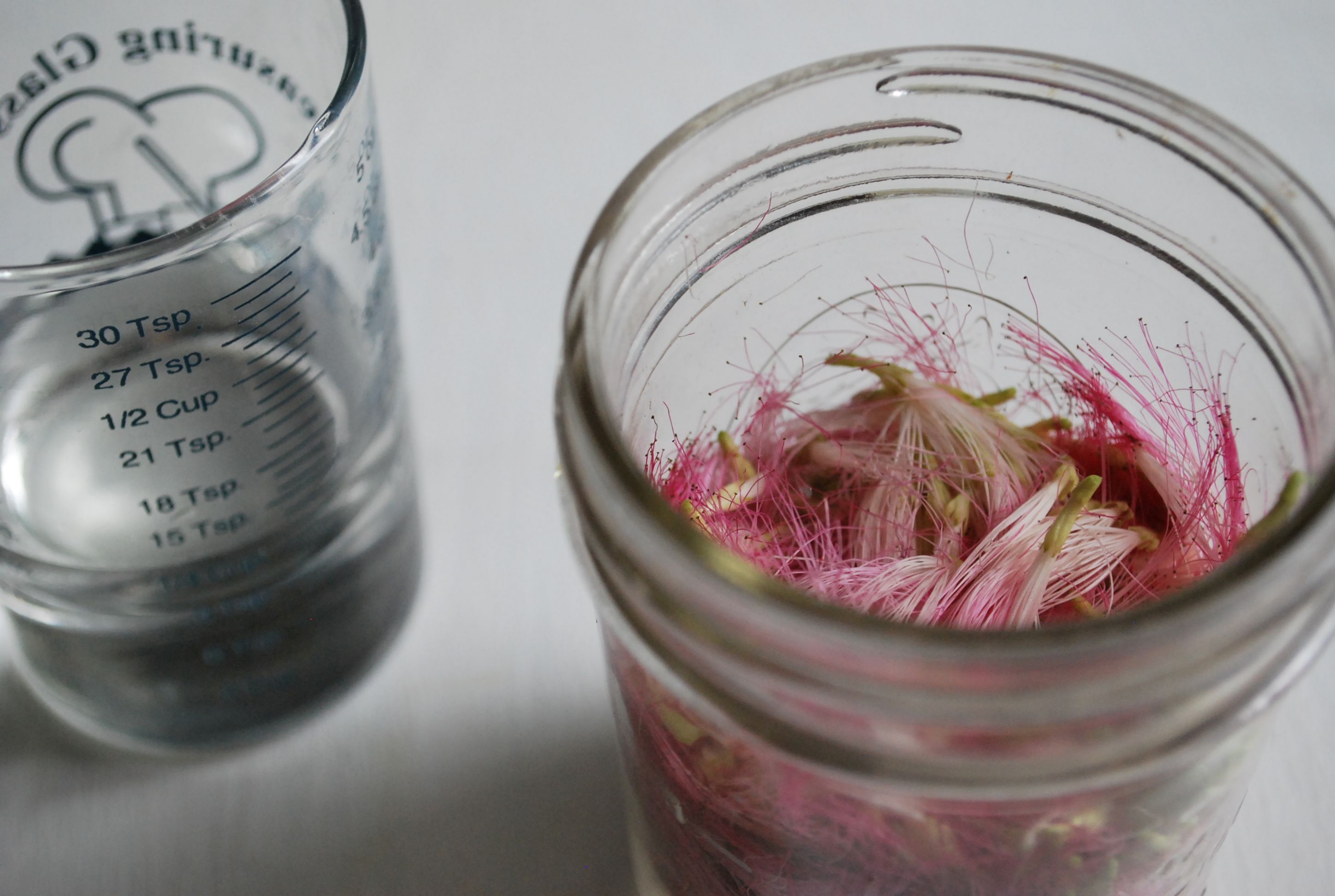
Step Four: Add Glycerin Mixture to Flowers
Now it’s time to combine the flowers and glycerin and prepare the jar to go into the water bath. Go slow pouring the glycerin into the jar – if you add too much, too quickly you can end up with a rather sticky mess.
- Gently pour glycerin mixture into the jar of albizia fluff until the jar is almost full. Leave ¼ headspace between the glycerin and the lid.
- Use the chopstick to release any air bubbles and make sure the glycerin reaches the bottom of the jar. You don’t need to stir everything but you can use the chopstick to poke between the fluff and the jar to allow the glycerin to seep down to the bottom.
- Allow everything to rest for a few minutes while the glycerin flows into the bottom of the jar to determine if you need to add more glycerin.
- Once the jar is full of glycerin mixture (remember to leave a ¼ inch headspace), apply the lid seal and the ring. Twist the ring gently but firmly to create a watertight seal.
Step Five: Water Bath Process Your Fresh Flower Glycerite
The heat is where the alchemy happens. Not only does it speed the process along- you can be done in 20 minutes instead of waiting weeks- but it also seems to strengthen the aroma and taste of the finished glycerite. Nothing I’ve been able to accomplish at room temp comes anywhere close to this.
- Using your jar tongs, gently place the lidded jar of flowers + glycerin mixture into the boiling water.
- Leave the jar in the pot of boiling water for 20 minutes.
- Carefully remove your jar from the boiling water bath using canning jar tongs and place it gently (still using the tongs) onto a clean baking rack or a folded towel on the counter.
- Allow your jar of glycerite to cool completely before going to the next step. Don’t forget to turn off the heat on the stove, too!
Step Six: Strain and Bottle Your Glycerite
After the jar has cooled completely, it’s time to strain the flowers from your albizia glycerite. Straining the flowers out is an important step to maintain the shelf life of your glycerite. I prefer to use a canning funnel that has a strainer built in to strain my glycerite straight into the amber bottle.
You can also use a fine mesh strainer to strain your glycerite into a measuring cup and then use a funnel to pour it into the amber bottle. I don’t like using coffee filters or muslin to strain my glycerites because it always seems like the process is too tedious and messy.
- Use a canning funnel with a built in strainer to bottle your glycerite. Alternatively, use a fine mesh sieve over a clean glass measuring cup to separate the flowers from the glycerin before transferring the finished glycerite to the amber bottle.
- Label and date your bottle of albizia glycerite. Store in the refrigerator- where it should have a shelf life of a year or longer.
I like to use a simple screw cap on my glycerites – no glass droppers. Glass droppers are easy to accidentally get dirty and contaminate your glycerite- eeew. You can use a clean measuring spoon to dole out our glycerite instead.
How to Use Your Albizia Glycerite
If you have questions about serving size for any herbal preparation, it’s best to find a local herbalist who can assist you. There are many different factors that influence what serving size might be best in your particular situation. Typically, though, glycerites are taken by the teaspoon (Easley & Horne, 2016).
Albizia glycerite has a very lovely, if unusual, taste. You can enjoy your glycerite straight from a spoon, drizzle it onto fruit, add it to yogurt, or put a little onto baked goods like toast, muffins, or even chia pudding or hot grain cereals. I also enjoy mine mixed into a little sparkling water with a few pieces of fresh fruit or berries.
My herbal recipe book, The Complete Guide to Adaptogens, is full of creative, simple ways to add herbs to your daily wellness routine and your menu!
All the best,
Agatha
